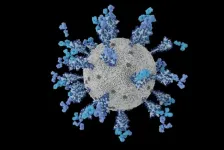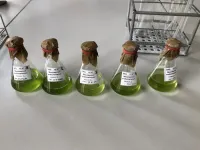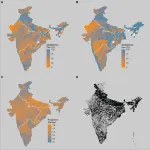(Press-News.org) The omicron variants of the SARS-CoV-2 virus, which have rapidly spread around the world over the past year, latch onto our cells more tightly, invade them more efficiently, and elude many of the antibodies induced by previous infections and vaccines. These are some of the key findings from a multinational team of researchers reporting today in the journal Nature.
The lead authors of the study were Amin Addetia, a graduate student, and Young-Jun Park, a research scientist, in the laboratory of David Veesler, professor of biochemistry at the University of Washington School of Medicine, and Luca Picolli, director of Humabs BioMed, Bellinzona, Switzerland, and James Brett Case of the Washington University School of Medicine in St. Louis. Veesler, who is also a Howard Hughes Medical Institute Investigator, headed the study.
“The omicron variants that have become dominant over the past year, such as BQ.11 and XBB.1.5, have high affinity for the receptor on host cells, angiotensin-converting enzyme 2, and they are able to fuse with the cell membrane and invade much more efficiently than previous SARS-CoV-2 omicron variants,” Veesler said.
Since the 2019 outbreak of SARS-CoV-2 in Wuhan, China,the virus has continually evolved. New variants of the original strain are constantly emerging. In some cases, these variants have proved to be less fit, thereby limiting their spread. But in other cases, more efficient variants have caused waves of infections and deaths.
The first omicron variant, designated BA.1 has been followed by a series of variants, each with mutations that increased their ability to infect and spread. These include variants designated BA.2, BA.4, BA.5, BQ.1.1, XBB and its derivatives XBB.1 and XBB.1.5.
They have also been able to reinfect people who had been infected by earlier variants and break through the immune protection of vaccines designed to protect against the earlier variants. These reinfections and breakthrough infections are possible because the new variants can evade antibodies induced by exposure to the earlier variants, Veesler and his colleagues found. Such antibodies, called neutralizing antibodies, prevent infection by quickly clearing an invading virus before it can become established.
However, the researchers also found that previous infection or vaccination did help to generate antibodies that recognized some of the proteins found on newer variants. These antibodies successfully activate immune cells that eradicate infection by killing and eliminating infected cells.
This immune response may explain why previous exposure to earlier variants or vaccination against them appears to reduce the risk of serious illness, hospitalization, and death with reinfection by a newer variant, Veesler said.
Although the neutralizing activity of most antibodies generated against earlier variants was much reduced, the effectiveness of one antibody, called S309, was retained.
This antibody targets a region on the virus’ spike protein that tends to remain relatively unchanged from variant to variant, presumably because its role is essential for the virus to function.
“S309 still recognizes all these variants and neutralizes them (albeit less efficiently), promotes the cellular response, and protects against disease in animal studies,” Veesler said.
The scientists explained one reason why previous infection or vaccination against earlier variants does not protect against infection by new variants as efficiently as with earlier variants: The immune system tends to react by producing antibodies induced by previous variants and cross-reacting with newer variants instead of producing new bespoke antibodies tailored to target the altered proteins on the new variants.
Veesler suspects this is due to a phenomenon called immune imprinting in which the immune response to a new infection by a similar virus is heavily influenced by the immune system’s earlier response. This immune imprinting leads it to concentrate on what it knows instead of learning new tricks to tackle the mutations found in the new variant.
This phenomenon is one reason why vaccines against new variants should not contain components from older variants that might favor immune imprinting and lead to a less effective immune response, Veesler said.
This research was funded in part by the U.S. National Institutes of Health (S10OD032290, T32GM007270); the U.S. National Institute of Allergy and Infectious Diseases (DP1AI158186, P01AI167966 and 75N93022C00036); the Burroughs Wellcome Fund; the Swiss Kidney Foundation; and the Research Council of Cantonal Hospital Aarau, Haru, Switzerland.
News release written by Michael McCarthy
END
Experiencing the harsh sounds of skateboarding can help bridge the gulf between the joy and distaste of the noises created by the sport, a new study says.
Skate sounds can also help individuals sense and feel the urban environment in new and novel ways.
Skateboarders have a specialised knowledge of the texture of cities, and sharing this with the public could help to soothe conflict, according to the research. Paying attention to sound can give both sides “sonic” agency over spaces in the city.
Skate sounds, are a common basis of complaint from the general public. Yet these sounds can act as a source of inspiration and joy for ...
UNIVERSITY PARK, Pa. — A new economic analysis has linked, for the first time, conduct problems among kindergarten students with significant costs to society in terms of crime and associated medical expenses and lost productivity when they are adults.
“Providing effective, evidence-based programming designed to address behavioral problems early on has the potential to improve students’ wellbeing in the long term,” said project collaborator Damon Jones, associate research professor in the Edna Bennett Pierce Prevention Research Center (PRC). “This study implies that there could be an additional benefit ...
New research published in the New England Journal of Medicine indicates that stem cell gene therapy may offer a promising, curative treatment for the painful, inherited blood disorder sickle cell disease (SCD).
The findings from a new clinical trial, published August 31, add to the body of evidence supporting gene therapy as a treatment for sickle cell disease, which primarily impacts people of color.
About 100,000 Americans have sickle cell disease, according to the U.S. Centers for Disease Control and Prevention. The condition, which can cause a lifetime of pain, health complications and expenses, affects one in 365 Black babies born in the U.S. and one ...
At the atomic and subatomic scales exist behaviors that have vast potential to enhance how we see and interact with the world, by improving current technologies and potentially giving rise to new ones. The main advantage to be gained from the realm of quantum sensing is its extreme sensitivity and accuracy, able to capture the faintest of signals and measure at the smallest of scales.
Now, several UC Santa Barbara researchers are poised to deploy their expertise in quantum science as part of the U.S. National Science Foundation’s (NSF) program ...
CHAMPAIGN, Ill. — Food was used as both a weapon and a tool of resistance in the Mississippi Delta during the Civil Rights Movement.
Bobby J. Smith II, an African American studies professor at the University of Illinois Urbana-Champaign, looked at how the Civil Rights Movement expanded to include struggles around food in his book “Food Power Politics: The Food Story of the Mississippi Civil Rights Movement.” The book is the inaugural title in the Black Food Justice series by the University of North Carolina Press.
Smith wrote about how white ...
A cancer diagnosis can increase the risk of infertility in young women. While consuming a healthy diet – including whole grains, fruits, vegetables, and healthy fatty acids – has been found to improve both fertility and cancer survivorship, over 90% of young adult cancer survivors don’t meet the dietary recommendations and have diets consisting of high fat and low fruit and vegetable intake. Researchers from Drexel University’s College of Nursing and Health Professions explored the barriers and ways to promote healthy diet practices among female cancer survivors with fertility challenges.
Recently ...
The Earth's surface is covered by plants. They make up the majority of biomass on land and exhibit a wide range of diversity, from mosses to trees. This astounding biodiversity came into existence due to a fateful evolutionary event that happened just once: plant terrestrialization. This describes the point where one group of algae, whose modern descendants can still be studied in the lab, evolved into plants and invaded land around the world. An international group of researchers, spearheaded by a team from the University of Göttingen, generated large ...
“In summary, our group demonstrates basic principles in the early aging of mammalian oocytes.”
BUFFALO, NY- August 30, 2023 – A new editorial paper was published in Aging (listed by MEDLINE/PubMed as "Aging (Albany NY)" and "Aging-US" by Web of Science) Volume 15, Issue 15, entitled, “Epigenetic aging in oocytes.”
Aging-related phenotypes span many different tissues and cell types, and start to occur at different ages - a different typical age for every cell type. In their new editorial, researchers Peera Wasserzug-Pash and Michael ...
MINNEAPOLIS – People who have had a stroke called an intracerebral hemorrhage who take cholesterol-lowering drugs called statins may have a lower risk of having another stroke, especially ischemic stroke, compared to people who also had an intracerebral hemorrhage but were not taking statins, according to a new study published in the August 30, 2023, online issue of Neurology®, the medical journal of the American Academy of Neurology.
Intracerebral hemorrhage is caused by bleeding in the brain. Ischemic stroke is caused by a blockage of blood flow to the brain and is the most common type of stroke.
“Previous research has had mixed results on the risk of ...
A relatively small intervention could have a huge impact on a damaging condition that stalks children in the developing world. A new Stanford-led study shows that adding zinc to farmland soil can help prevent childhood stunting, a condition due to chronic undernutrition that is associated with poor brain development and long-lasting harmful consequences, such as reduced school performance and increased disease risks. The paper, published Aug. 21 in Scientific Reports is the first large-scale study to examine the association between children’s nutritional status or health outcomes and soil mineral availability in India, ...





